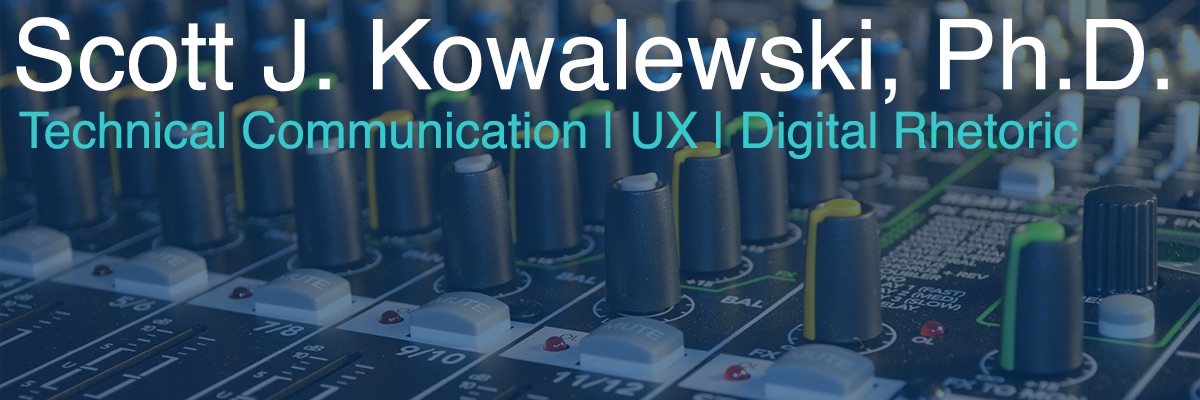Teaching Philosophy
Keeping in mind, as Marilyn Cooper asserts, that “writing is an activity through which a person is continually engaged with a variety of socially constituted systems” (“The Ecology of Writing” 367), I ground my teaching philosophy in writing ecologies. “Writing, of course,” as Sidney Dobrin tells us in Ecology, Writing Theory, and New Media, “is an ecological phenomenon. It is spatial, relational, and complex…” (2). A pedagogy that emphasizes writing ecologies confronts and reflects on relationships between the social, contextual, material, and evolving nature of textual production. Through my experiences as a professional writer and teacher of writing, I know good writers can adapt to a variety of situations, and in the composition and technical/professional writing courses I teach, I help my students see themselves in relation to the broader ecologies that influence their rhetorical choices—helping them learn to flex and adjust to the material and immaterial affordances and constraints of textual production. I believe a pedagogy that situates the writer in relation to the various elements of production creates adaptable, flexible writers. I strive to achieve this pedagogy in three ways:
- Encouraging students to explore their questions and curiosities while developing the habits and dexterity of researchers.
- Preparing students to be effective twenty-first century communicators, as critical (and rhetorical) users of the tools and technologies of textual production.
- Establishing a communal space where ideas develop and writing is seen as always enmeshed in a variety of social and technological systems.
Developing Student-Researchers
One of the challenges of a writing ecology pedagogy is moving students away from a “performing for the teacher” mindset and toward viewing their writing as contributing to issues and addressing audiences beyond the classroom—indeed, as part of existing and ongoing social systems of knowledge. I want students to encounter the (initially uncomfortable) space of not knowing the answers to their questions; this space creates the exigency for exploration. I enact this approach through community-engagement assignments. In my technical writing course, for example, students conduct community-based research by exploring an environmental, health, or risk management issue in a localized area. Working in collaborative groups, students conduct fieldwork, consider academic and popular sources, and use a variety of qualitative and quantitative research methods—including interviewing and surveying primary stakeholders—to develop a technical report for future action. By investigating their questions through community engagement, academic inquiry, and the habits of technical communicators, students develop agency as (technical) writers and consider primary, secondary, and tertiary reader-users, as they manage information to promote civic action. They also see their work as being situated in the communities they investigated and the complex relationships between space, audience, technology, and the workplace that exist in writing ecologies.
“Many hands-on projects that helped me better understand the field of usability through experience.” –RPW 324 (Special Topics: User-Centered Design and Usability Studies) Student
Preparing Twenty-First Century Communicators
Considering Stuart Selber’s explanation of functional, critical, and rhetorical literacies, being an effective twenty-first century communicator means knowing new media spaces and (digital) technologies provide writers with affordances for multimodal and multimedia communications. It is important, therefore, that students develop the rhetorical understanding to know when these types of compositions are more appropriate for particular audiences and situations. As Anne Wysocki indicates in Writing New Media, though, “new media texts do not have to be digital” (15), and twenty-first century communicators recognize the materiality of production as part of a writing ecology, whether in digital or analog spaces. As a teacher of writing, I help my students become aware of the ways the tools and technologies influence textual production. When creating a digital video project, for example, they begin by using markers and index cards to create a storyboard. Spreading the index cards across their desk or the floor, they arrange and rearrange the order of their video in physical spaces—seeing and touching the discrete components—before moving to a nonlinear editing program like iMovie or MovieMaker. Moving as (and between) functional, critical, and rhetorical users of technology, students are better aware of the ways in which our tools are intertwined with social and material elements of writing, and they enact their knowledge of the tools and technologies of production appropriately and efficiently.
“We had student led discussions, which were great for learning and applying new material[…].” –RPW 300 Student
Creating a Communal Space
My classroom is a workshop where students share and discuss their writings and ideas; it’s a space that encourages and fosters an environment of diversity and mutual respect. I understand that students come to college with diverse experiences, and I embrace this diversity; we all participate in knowledge construction and learn from each other. I not only share my experiences and writings, but students’ ideas and writings are inherently central to each class. I achieve this rapport through class discussions and small group activities that demonstrate how writing functions in and across discourse communities such as the university and the workplace. One activity in my technical writing course asks students to work in small teams and lead a class discussion related to course topics (e.g. workplace ethics and document design). Student-teams develop several open-ended questions that address current issues in technical communication and locate relevant print and online resources. Discussions make connections with elements of technical communication such as writer agency, the role of reader-users, collaboration, and workplace practices as well as connections with how these elements interrelate with various social contexts, creating the writing ecologies technical communicators inhabit.
A writing ecology pedagogy emphasizes the dynamic nature of writing and asks the student-writer to consider (and reflect on) the social, material, contextual, and evolving nature of writing. And that is perhaps the most intriguing aspect of a writing ecology pedagogy: the writer is always confronted with the relationship between writer, audience, genre, and materials of production. Student-writers must learn to flex and adapt, and being flexible, adaptable producers of text allows students to make (rhetorical) choices about the best communicative means for their academic, professional, civic, and personal endeavors.
